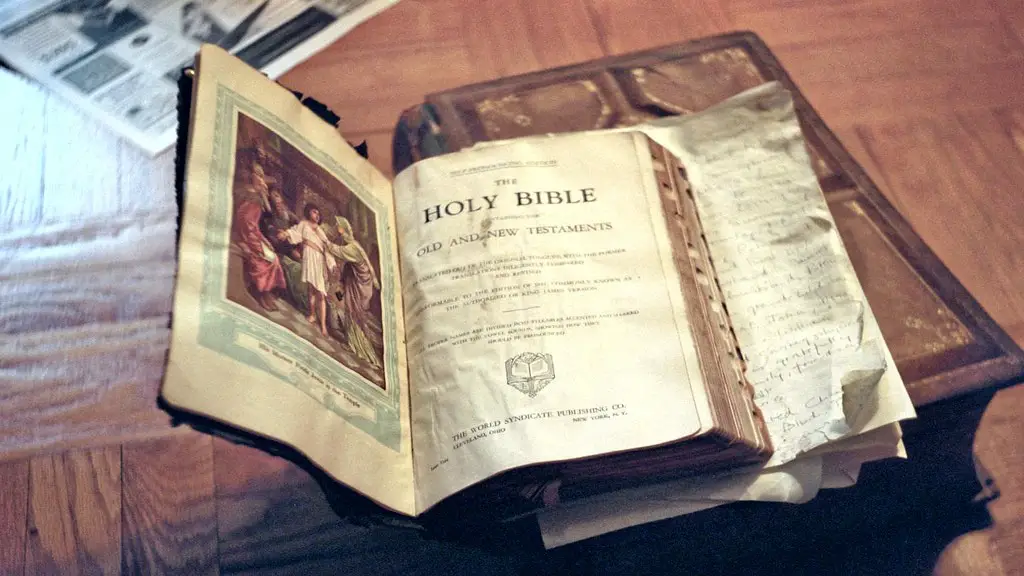The Bible is one of the most important books in history, transcending time, language and cultures. It consists of 66 books divided into the Old Testament and New Testament. Ever wondered what the books of the Bible in order were? Read on to find out more.
The books of the Bible are arranged in an order that is generally accepted among all believers. The division between the Old Testament and New Testament books is a reflection of the different times of authorship. The Old Testament, dating from approximately 1500 BCE to 400 BCE contains 39 books, while the New Testament, compiled between 50 CE and 150 CE, contains 27 books. The Bible begins with the Old Testament books and then continues on with the New Testament books.
Before organizing the Bible in order, it is important to understand the different genres of books in the Bible. Within the Old Testament, there are five types of book: Law, History, Poetry and Wisdom literature, Major Prophets, and Minor Prophets (also known as the Latter Prophets). Similarly, the New Testament contains four types of books: The Gospels, Acts, Letters, and Revelation. Although the contents of each book may vary, they all serve a purpose to provide insight into the spiritual lives of the people of God.
When organizing the books of the Bible in order, first, it is important to note that the books are not listed in the same order throughout each version of the Bible. For instance, some of the major differences between the King James Version and the New International Version include the order of the books of Samuel, Kings and Chronicles, as well as the order of the minor prophets.
The Old Testament begins with the Books of Moses, also known as the Pentateuch. This section contains the books of Genesis, Exodus, Leviticus, Numbers, and Deuteronomy. These books recount the origins and history of the Jewish nation up to the time of Moses. Following the Pentateuch, the books of Joshua, Judges, Ruth, 1 and 2 Samuel, and 1 and 2 Kings are listed. These books provide a detailed historic narrative spanning the period of the Israelite monarchy up to the Babylonian Exile. Next, the books of 1 and 2 Chronicles, Ezra, Nehemiah, and Esther come before the poetic books, which contain the books of Job, Psalms, Proverbs, Ecclesiastes, and Song of Songs.
The books of the prophets are next, divided into major prophets and minor prophets. The major prophets, Isaiah, Jeremiah, Lamentations, Ezekiel, and Daniel, all provide a prophetic narrative to the people of the nation of Israel. The minor prophets, Hosea, Joel, Amos, Obadiah, Jonah, Micah, Nahum, Habakkuk, Zephaniah, Haggai, Zechariah, and Malachi, are followed by the Books of Maccabees and 1 and 2 Esdras (also known as Nehemiah and Ezra).
The Gospels
The New Testament follows the Old Testament and begins with the Books of Gospels. These books, Matthew, Mark, Luke and John, all provide a personal account of Jesus’ life, ministry, death and resurrection. After the Gospels comes the book of Acts, providing a continuation of Jesus’ ministry, spread of the gospel and the growth of the early church.
Following Acts are the letters or epistles from Paul, the most influential figure in the early church. The Pauline epistles, divided into prison and non-prison epistles, begin with Romans, and conclude with Philemon. These are followed by the book of Hebrews and then followed by the General epistles of James, 1 Peter, 2 Peter, 1 John, 2 John, 3 John, and Jude. Finally, the bible concludes with the apocalypse or Revelation.
Order of Canonization
The canonization of the bible, or the process by which books were selected, is important to understand when ordering the books in the bible. The process of canonicalization is accepted to have been an organic one and is said to have begun in the early second century CE and completed in the late fourth century CE. Throughout the process, many criteria were taken into consideration by the early church leaders, including apostolicity, antiquity, prophetic-historical accuracy, reception by the wider church, and spiritual or practical guidance. After judging each book according to these criteria, the cannon was eventually settled from the Old Testament with 46 books and from the New Testament with 27 books.
36 Non-Canonical Books
Be aware that some bibles are followed by a set of 36 non-biblical books in the Apocrypha. These books, such as 1 and 2 Maccabees, Tobit, and Sirach, were written during a period when the Bible was already completed and are not accepted by all Christian denominations. However, they are important because they provide insight into the second temple period.
Implications of Bible Order
Organizing the books of the Bible in order provides a structure and helps its readers understand the content of the Bible more clearly. It also reveals the Bible’s divine authorship and order reflects the purpose God had in mind — a message of redemption to the entire world. It is no coincidence that the Bible begins with creation and ends with the final days of a new heaven and new earth.
In modern times, bible readers have been fortunate to have an array of helpful tools to help them navigate the Bible. Outlines and maps are available to assist in understanding the books of the Bible in their correct order. Study tools such as cross-referencing, concordance and bible software have made reaching a deeper understanding of the text much easier than in the past.
Unique Perspectives
A unique and interesting way to even further understand the Bible’s order is to read each book in its entirety and track the fading of Israel’s darkness into the dawning of Jesus’s kingdom. This in itself will provide a more meaningful and immersive experience to appreciate the text, its themes, messages and purpose.
Theology of the Bible Order
In order to truly understand the order of the books of the Bible, one must take a look at its theology. The structure of the Bible is that of a story, a story of God’s relationship with his people. In the beginning, this relationship was perfect and was exemplified through the creation of man and woman (Genesis). The next few chapters (Exodus, Leviticus, Numbers and Deuteronomy) detail the law that God gave his people to live by, which was to help them remain in harmony with his will. Then, the tragic fall of man is depicted in the Books of Samuel and Kings, followed by the Prophets who attempt to turn the people back to God’s law. Finally, the New Testament follows, detailing the plan for redemption through Jesus Christ.
Conclusion
The order of the books of the Bible is a testament to its divine nature and indestructible unity. Despite its length and seemingly unlimited interpretative possibilities, the overall progression and structure demonstrates the hand of an orderly and merciful God. When studying the structure of the Bible, it will become increasingly clear why it is the world’s most beloved and enduring book.



